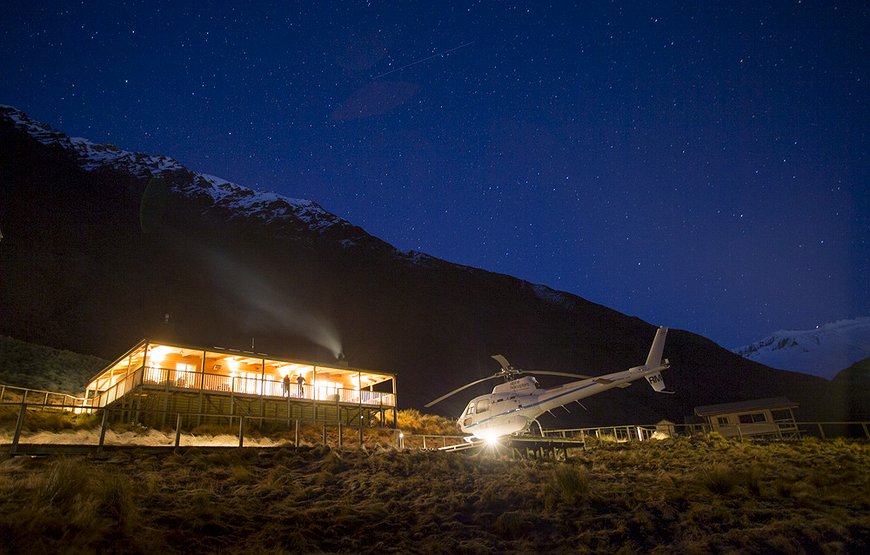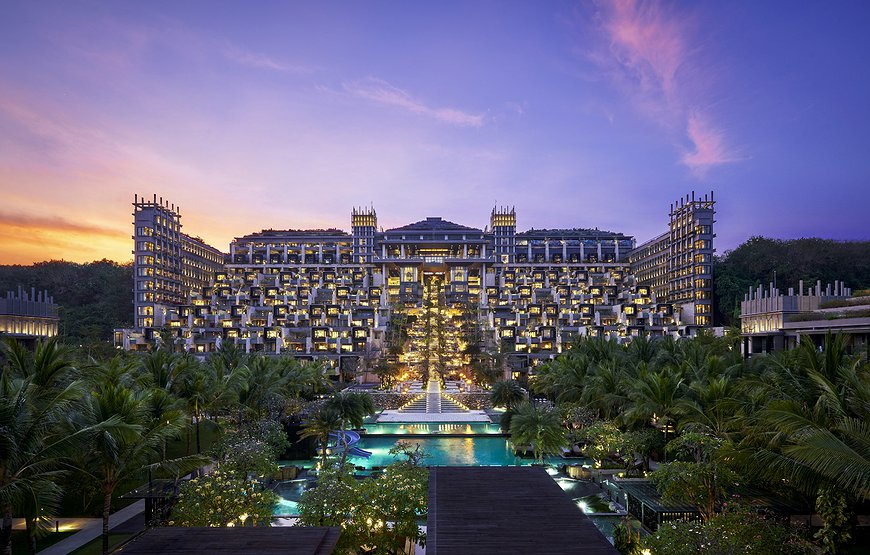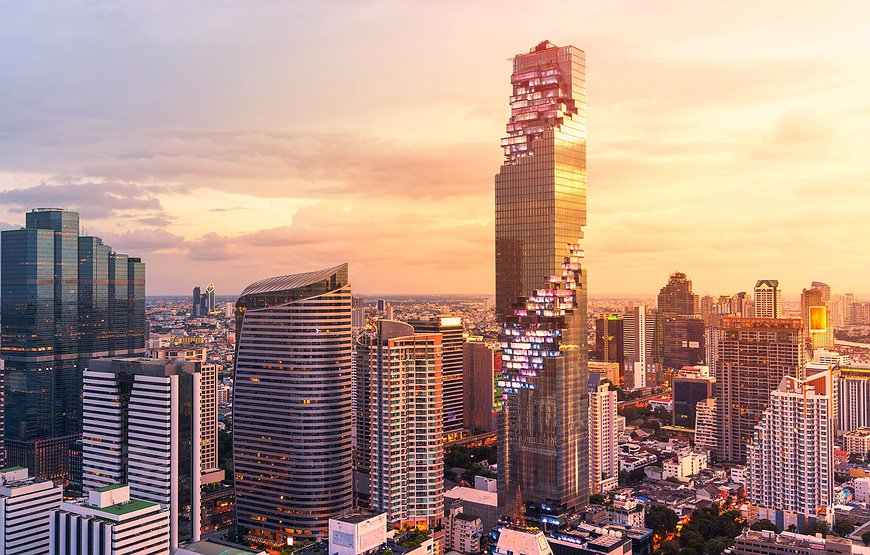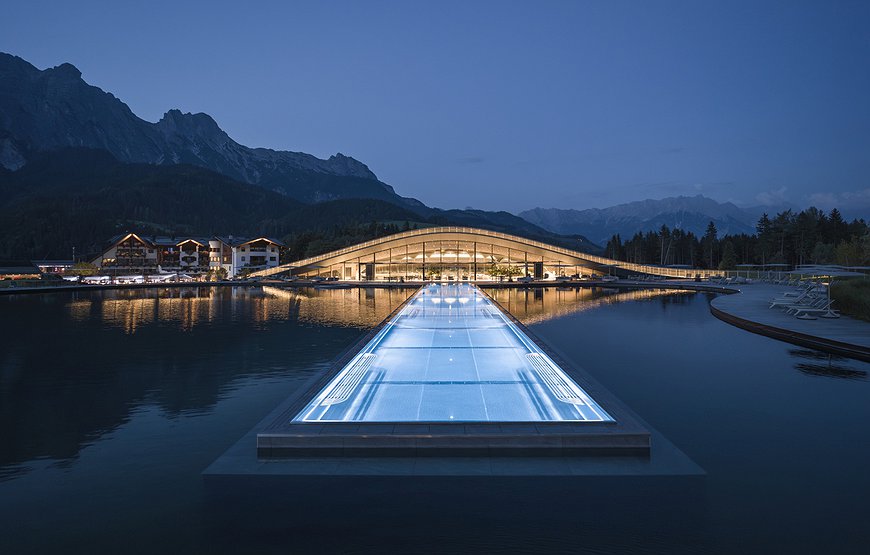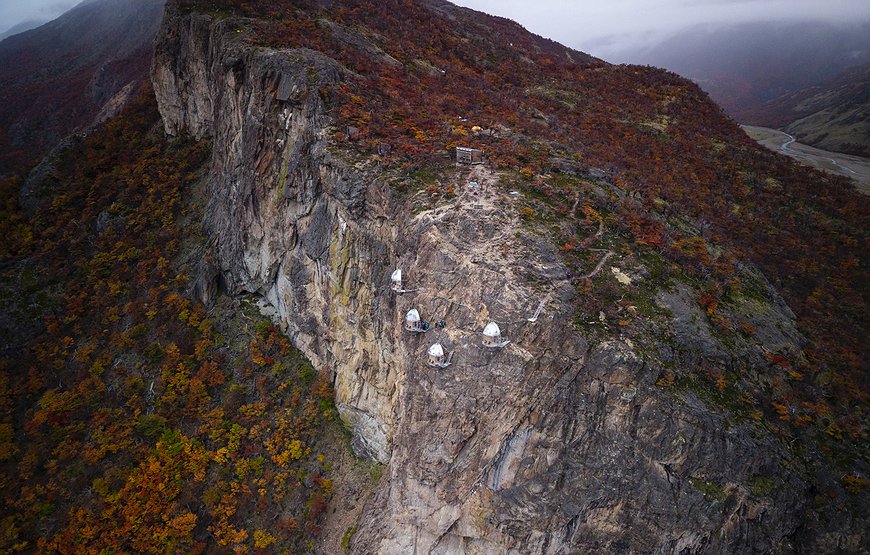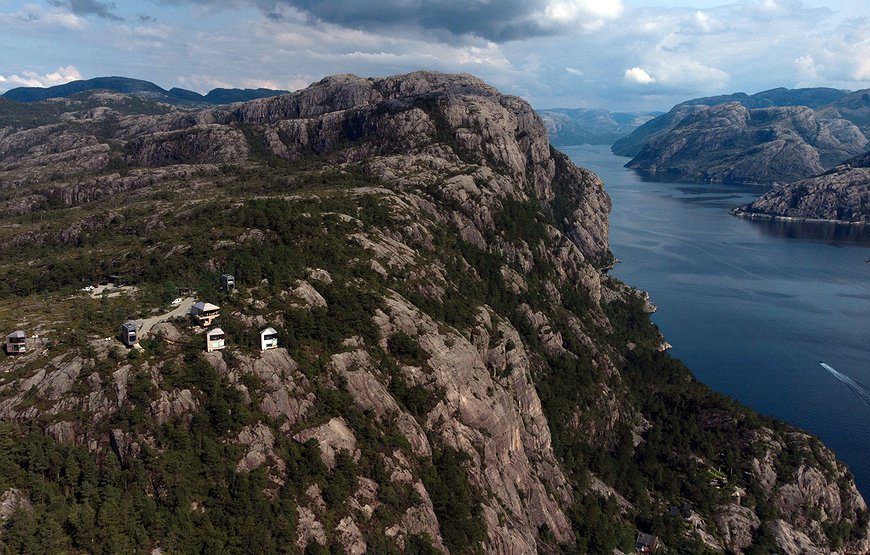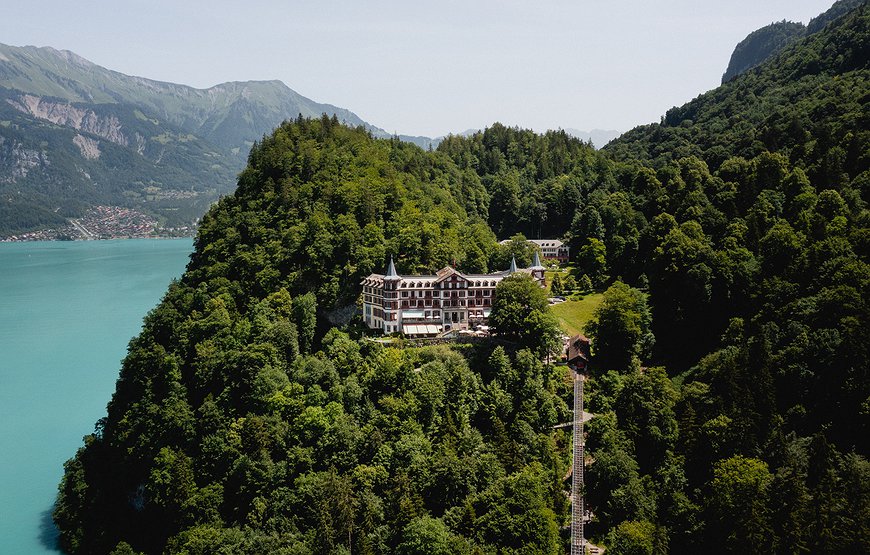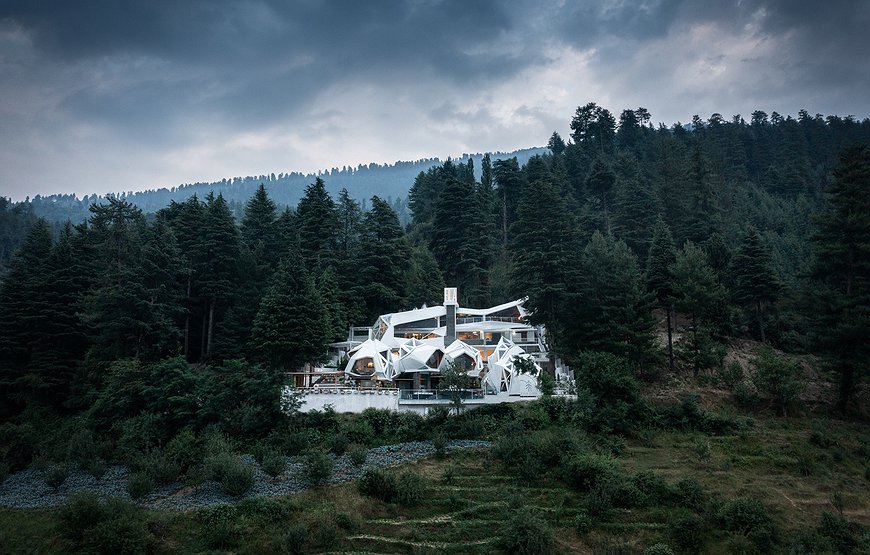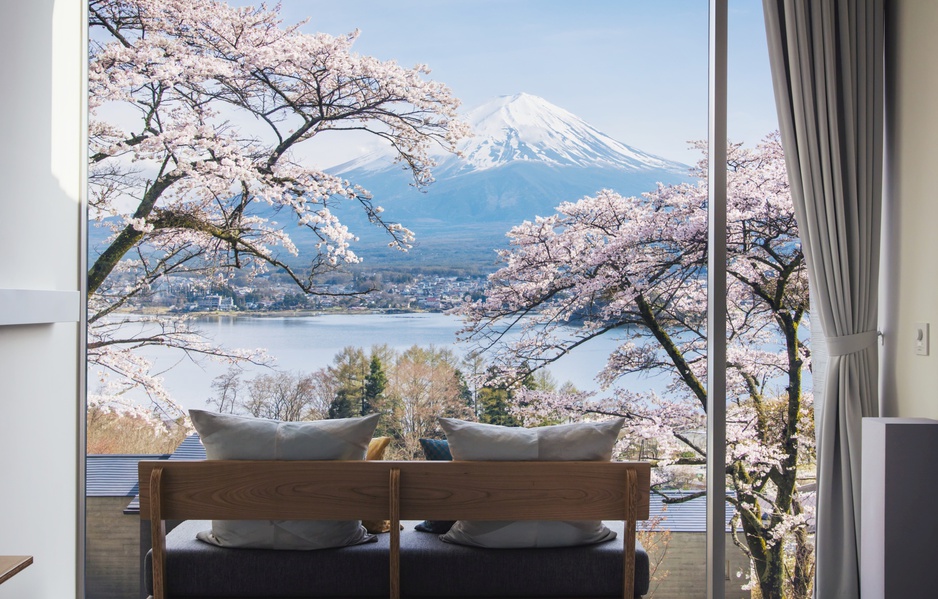
Imagine waking up to Mount Fuji framed in floor-to-ceiling windows, then stepping onto your private terrace to toast marshmallows by a built-in fireplace – all while someone else handles the cleanup. Welcome to HOSHINOYA Fuji, where camping meets five-star comfort in the most unexpected ways. Japan's first glamping resort takes everything annoying about traditional camping (the bugs, the cold, the portable toilets) and tosses it out, keeping only the good bits: crackling fires, forest air, and that peculiar joy of eating outdoors. Nestled in a red pine forest overlooking Lake Kawaguchiko, these 40 minimalist concrete cabins prove that you can sleep under the stars without actually sleeping under the stars.
Location: Where Volcanic Drama Meets Lake Views
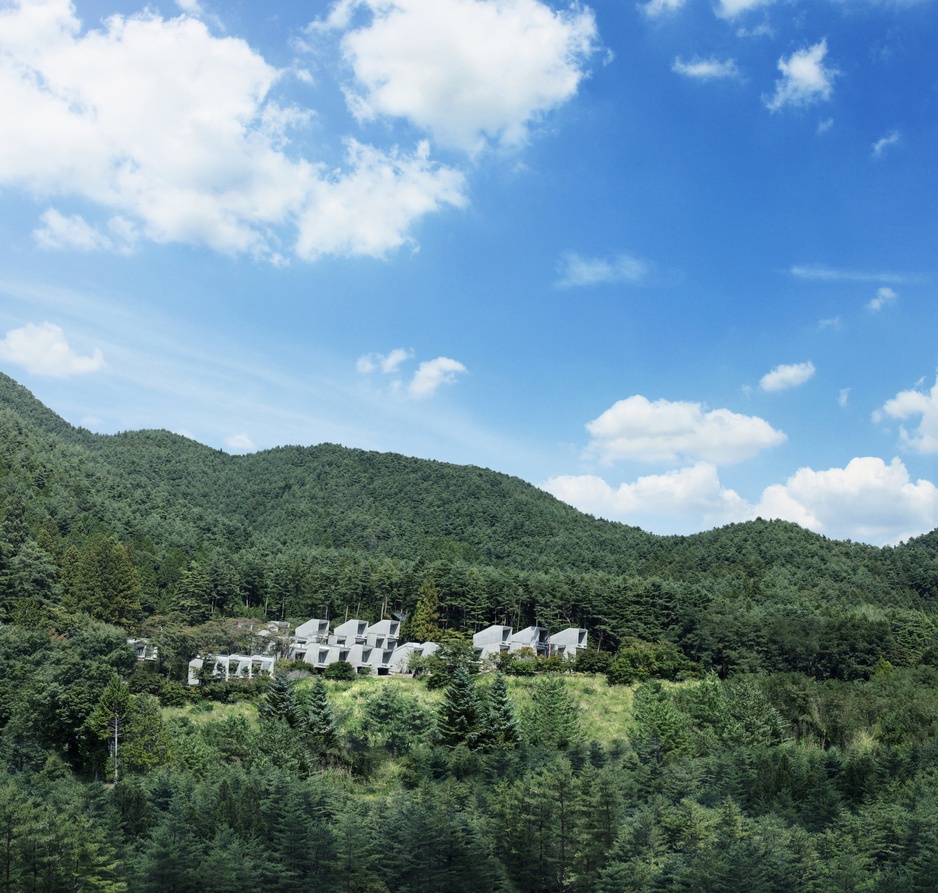
Photo by Hoshino Resorts
HOSHINOYA Fuji sits on a hillside just north of Lake Kawaguchiko, part of the Fuji Five Lakes region that formed from volcanic activity 10,000 years ago. The landscape still bears the dramatic scars – craters, ice caves, and mixed forests of deciduous trees and evergreens scattered across the terrain. Mount Fuji, Japan's highest peak and a UNESCO World Heritage site since 2013, dominates the southern view.

Photo by Hoshino Resorts
The resort faces south, catching sunlight throughout the day while offering an unobstructed sightline to the iconic mountain across the lake. It's roughly two hours from Tokyo by train or bus, close enough for a weekend escape but far enough to feel properly removed from city life.
Architecture: Concrete Telescopes in the Trees

Photo by Hoshino Resorts
Architect Rie Azuma designed the cabins as minimalist concrete cubes that seem almost brutalist at first glance – until you realize they're essentially telescopes pointing at Mount Fuji. The unadorned concrete exteriors blend surprisingly well into the red pine forest, creating a contemporary contrast against the organic surroundings. Inside, the design philosophy is simple: strip away everything that might distract from the massive windows framing Lake Kawaguchiko and the mountain beyond.

The cabins overlooking Lake Kawaguchiko - Photo by Hoshino Resorts
The cabins are deliberately sparse, with subdued colors and clean lines that make the outdoor view feel like part of the room itself. Each structure dedicates roughly a third of its floor plan to an outdoor terrace, blurring the line between inside and outside in a way that feels both Japanese and decidedly modern.
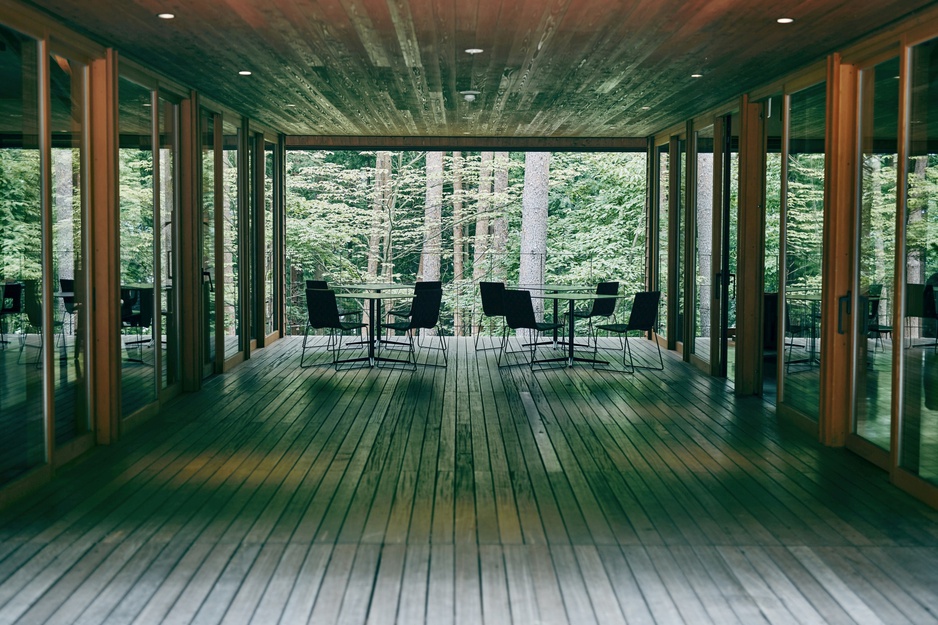
Front desk - Photo by Hoshino Resorts
Check-in happens at a base station at ground level, where staff help with bags before presenting you with an unusual choice: picking a backpack for your stay. The wall of outdoor packs contains water bottles, tumblers, headlights, snacks, and other camping essentials – a tangible reminder that despite the luxury, this is meant to feel like an adventure. After selecting your pack (kids get their own miniature versions), you're driven up the hillside in a Jeep Wrangler. It's a small detail, but the off-road vehicle and the climbing route immediately shift the mental state from hotel arrival to mountain expedition.
Dining Room: Grills, Flames, and Mountain Fare
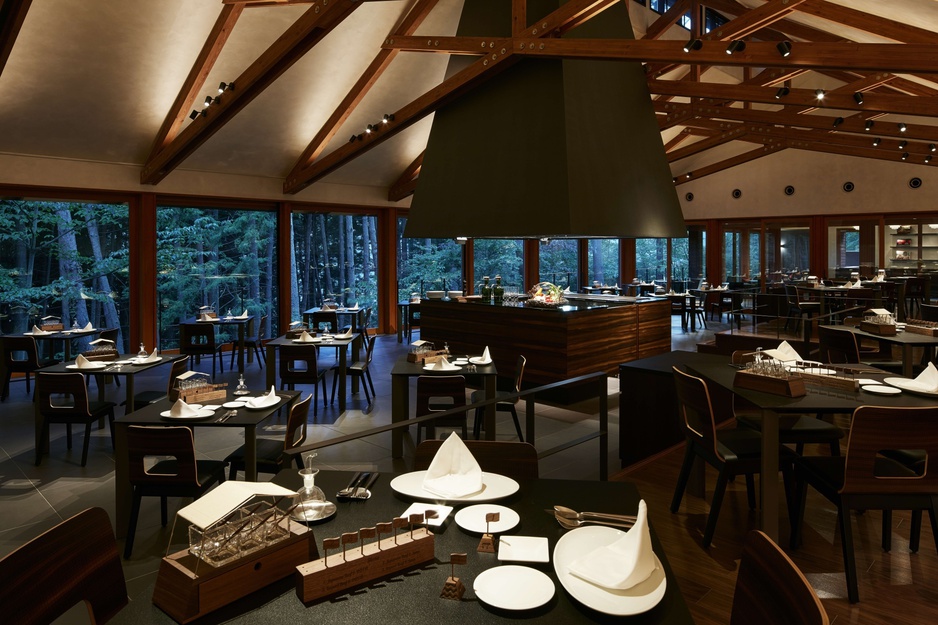
The Dining Room - Photo by Hoshino Resorts
The dining hall centers around a large grilling station where chefs cook over open flames while you watch. The menu focuses on what they call "Gastronomic Wild" – local ingredients from the Mount Fuji region prepared to maximize their natural flavors. Game meat features prominently, sourced from local hunters, alongside seasonal vegetables and Koshu grapes used in regional wines. The cooking methods skew toward camping traditions reimagined: deeply roasted vegetables, crispy fritters, robust grilled dishes. One dessert arrives finished with a splash of Hakushu Whisky, adding a smoky, campfire-evoking aroma.
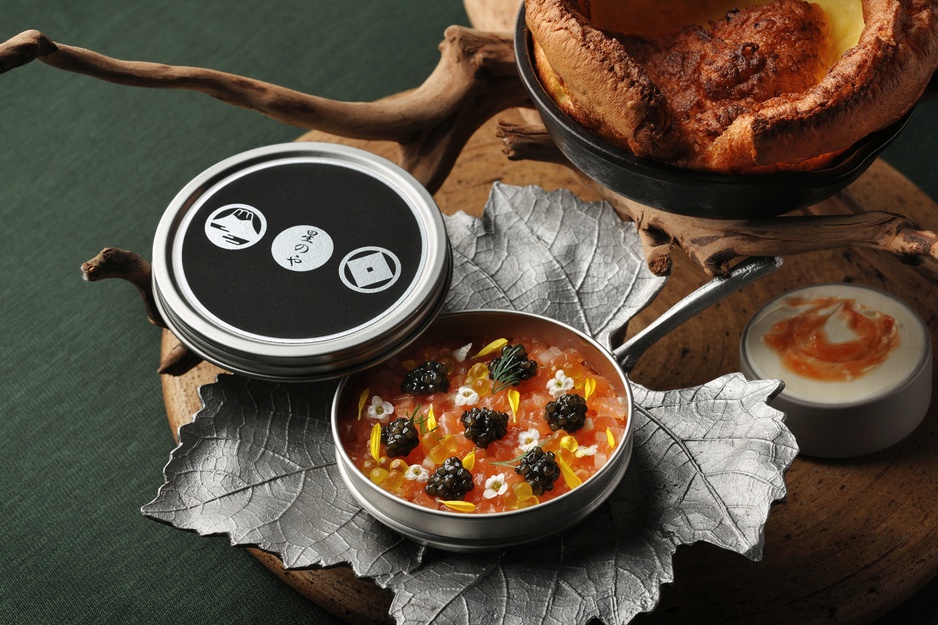
Grill dinner appetizer - Photo by Hoshino Resorts
Everything is designed to taste like camping at its absolute best, minus the charred bits and the mystery meat from questionable coolers. The dining hall feels communal, with the sounds of sizzling food and lively conversation bouncing off the high truss ceiling – a far cry from the hushed formality of traditional Japanese fine dining.
Rooms: Five Types of Mountain-Facing Minimalism

D-cabin - Photo by Hoshino Resorts
The 40 cabins come in five configurations, all sharing the same design philosophy but differing in layout. T Cabins offer twin beds and spacious terrace living for up to two people. D Cabins feature king-size beds in 39 square meters, with two variations: one with a terrace sofa, another with deck chairs. F Cabins are slightly larger at 47 square meters with three beds, designed for families – uniquely, one bed can be moved closer to another for young children. S Cabins are the premium option, with only two available across the entire property, distinguished by wood stoves on their terraces overlooking the lake.
Every cabin includes air conditioning, floor heating, and proper bathrooms with bathtubs and Japanese washlet toilets – the luxuries that separate glamping from actual camping. Bluetooth speakers, humidifiers, and mini bars round out the amenities. Rain boots sit ready by the door for forest exploration. The interiors remain deliberately minimal, with most furniture serving the single purpose of orienting you toward those massive windows and the view beyond.
The View: Mountain Mornings and Cloudy Afternoons
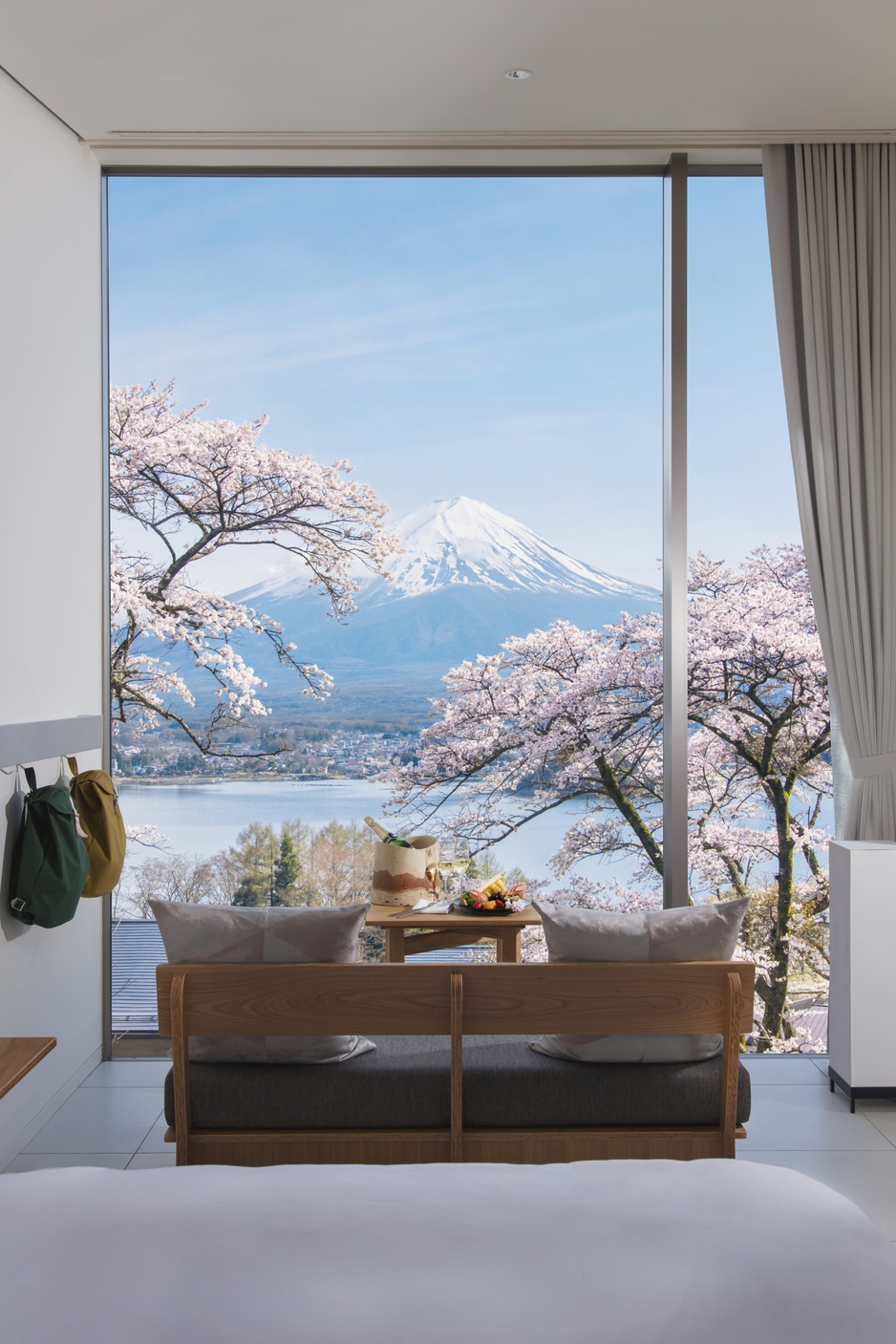
Photo by Hoshino Resorts
That view – Lake Kawaguchiko stretching out below, Mount Fuji rising beyond – justifies the entire concept. On clear days, the mountain appears in perfect symmetry, its snow-capped peak reflecting in the lake's surface. But even when clouds roll in (which happens frequently), the landscape constantly shifts and transforms. Cherry blossoms paint the hillside pink in spring, while fall brings explosive reds and oranges from maple leaves. The volcanic geography from 10,000 years ago creates a varied terrain of forests and geological formations that change appearance throughout the day as sunlight moves across the slope. The floor-to-ceiling windows turn each cabin into a living landscape painting, the kind that updates itself hourly.

Photo by Hoshino Resorts
The terraces are where HOSHINOYA Fuji's glamping concept truly comes alive. Each balcony features a built-in fireplace – not some sad portable fire pit, but a custom-designed table with one end specifically engineered to maintain a proper fire at night. Wide sofas encourage you to stretch out as if indoors, but you're breathing mountain air and feeling the temperature drop as evening settles in.

Photo by Hoshino Resorts
In winter, heated kotatsu tables (low tables with blankets draped over them and heaters underneath) appear on the terraces, creating impossibly cozy spots to sit for hours. Staff known as Glamping Masters come by to light fires after dark, tending the flames so you can enjoy the crackling warmth without the hassle of fire-starting. The outdoor space becomes the main living area – a place for morning coffee, afternoon reading, evening wine, and late-night conversations under the stars.
Breakfast Box: Dutch Ovens and Tackle Boxes
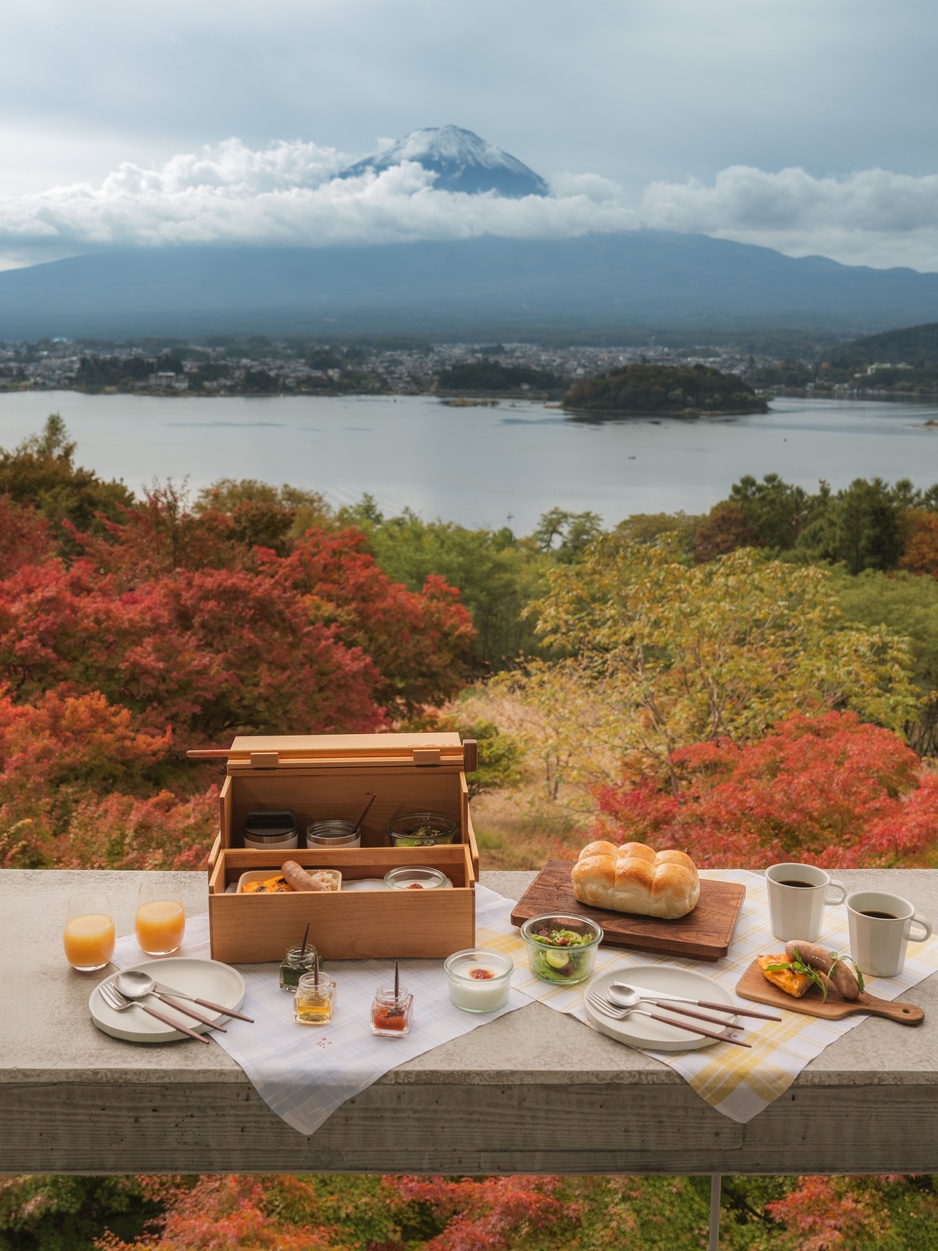
Breakfast Box - Photo by Hoshino Resorts
The Breakfast Box arrives in a handcrafted wooden container designed to mimic a fishing tackle box, a nod to Lake Kawaguchiko's bass fishing heritage. Inside: Dutch oven-baked bread (a standout, according to most accounts), smoked organic sausages, seasonal fruit, omelettes, mushroom soup, yogurt, and herbal tea.
The meal is set up on your balcony while you're getting ready, so you step outside to a fully prepared spread with the morning view. It's the kind of breakfast that makes you wonder why anyone eats indoors – crusty bread and strong coffee while Mount Fuji emerges from morning mist feels like an entirely different meal than the same food at a dining room table.
Cloud Terrace: Suspended Living in the Pines

Cloud Terrace - Photo by Hoshino Resorts
The Cloud Terrace network begins where the cabins end, climbing into the red pine forest through a series of layered wooden decks that seem to float among the trees. At the top sits the Library Café, stocked with books about nature, food, and Mount Fuji, warmed year-round by a wood-burning stove.
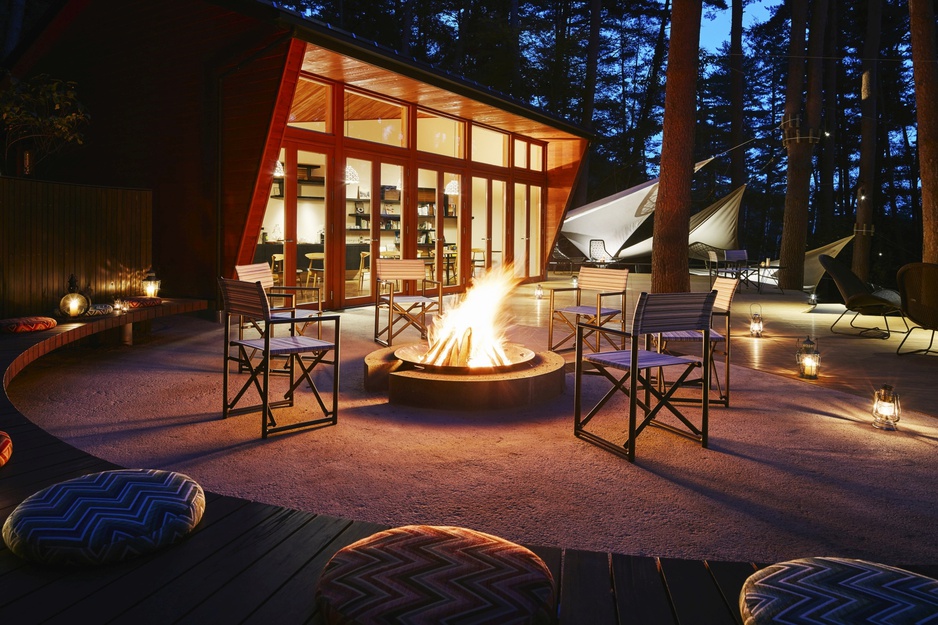
Photo by Hoshino Resorts
The fire serves as a gathering point for those who make the trek to the highest point of the resort, a small reward for the climb. The Takibi Bar operates from early morning until 9:30 pm, serving whisky, wine, and beer for those who want to linger by the bonfire late into the night.

Photo by Hoshino Resorts
The lower terraces feature deep backless sofas and hammocks where you can lie flat and stare up through the pine canopy. Air benches and chairs are positioned to naturally tilt your gaze skyward, designed to encourage a sense of unity with the towering trees. When sunlight filters through the leaves, the spacious middle deck becomes a dappled sanctuary for losing track of time.
Activities: Smoking Your Own Dinner
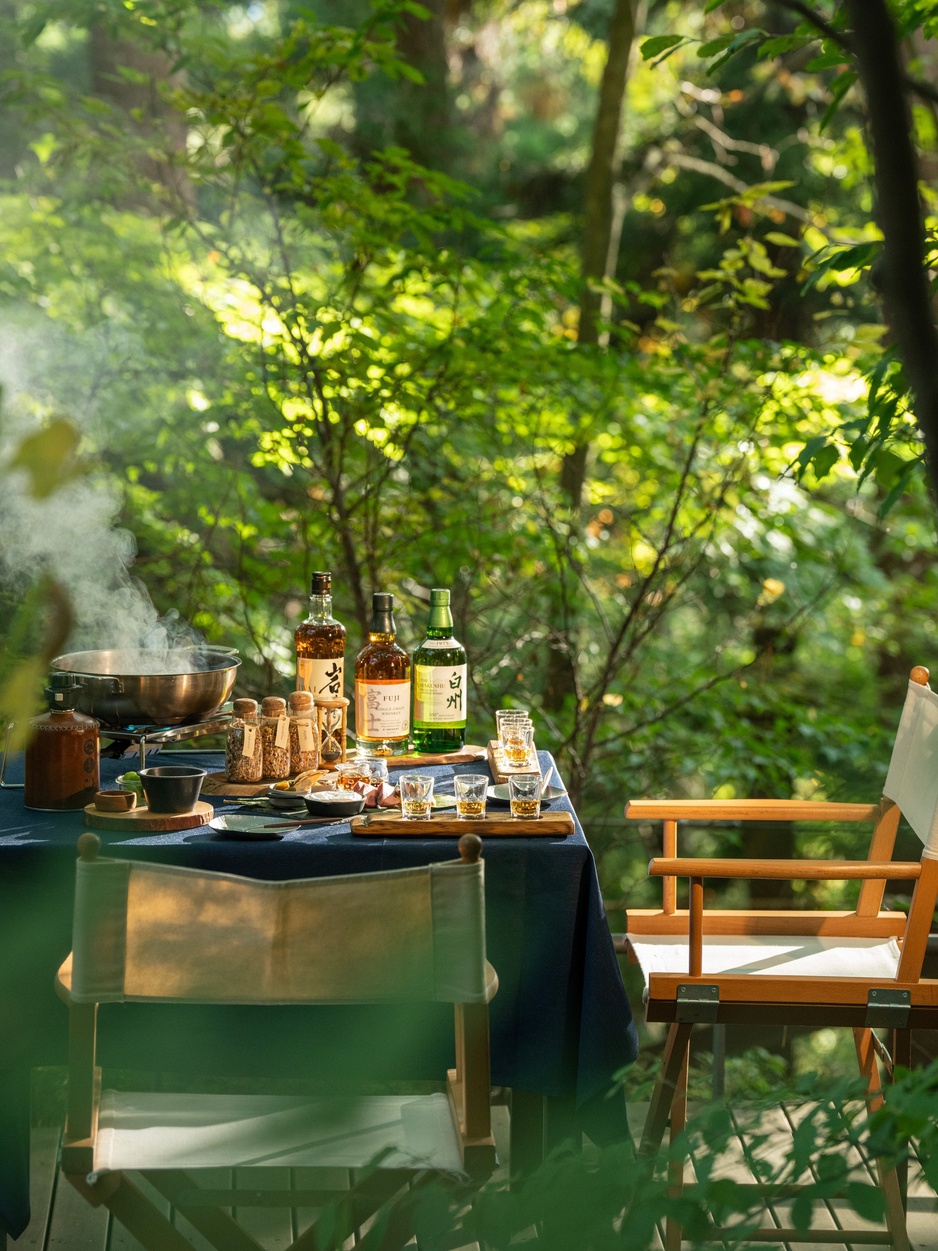
Food smoking workshop - Photo by Hoshino Resorts
While early morning canoeing on Lake Kawaguchiko and electric bicycle tours draw crowds, the Food Smoking Workshop captures the resort's glamping philosophy perfectly. You select woodchips – different varieties create different flavor profiles – then smoke seasonal ingredients with guidance from a Glamping Master. The process demystifies a traditionally finicky cooking method, turning it into something approachable while maintaining genuine technique. Once smoked, the food pairs with whisky or beer while you sit by one of the terrace fires.
Other activities range from wood chopping demonstrations to forest concerts performed nightly by rotating artists, stone oven pizza workshops where you roll your own dough, and guided nature treks through the volcanic landscape. The resort's motto of eliminating camping's downsides while expanding its pleasures applies directly – you get the satisfaction of outdoor skills without the frustration of actually having to master them under challenging conditions.
1408 Oishi, Fujikawaguchiko, Minamitsuru District, Yamanashi 401-0305, Japan


